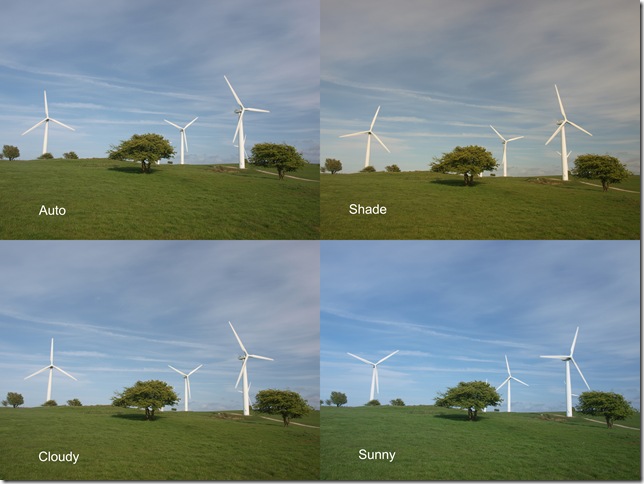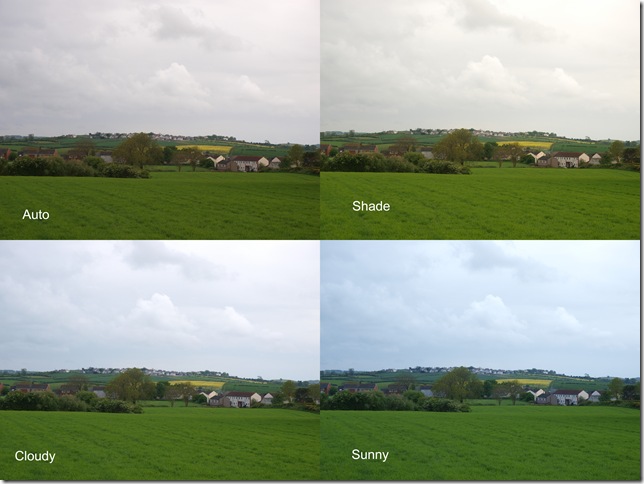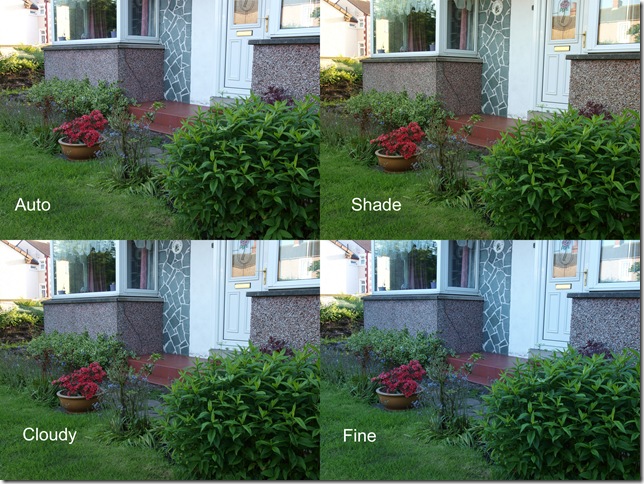What I would expect from this exercise is that photos taken in high colour temperature light will appear cool (or bluish) when using a light balance for a lower colour temperature, and conversely, photo taken in lower temperature lighting will take on a more red/yellow tone when using a higher temperature light balance. The classic example of this latter effect is the orange appearance of photos lit by tungsten lights and taken on normal film, or outdoor colour balance settings.
Sunny conditions
All the following, which were taken near Bothel, Cumbria, were shot at 14mm, using 1/80 at f/9 and ISO 100.

As we can see even in this small picture the ‘cloudy’ version is less blue than the ‘sunny’ version, and the ‘shade’ version even more so. In the latter case the clouds begin to take on a rather un-natural violet hue, and the overall photo looks a bit muddy. I would have expected that the ‘auto’ and ‘sunny’ setting would agree, but i reality the auto version sits somewhere between the ‘cloudy’ and ‘sunny’ versions. This is possibly because the thin high cloud visible in the photos has altered the colour temperature slightly.
Whatever the case, it feels to me that ‘auto’ gives a slightly more pleasant rendition of the scene. The ‘sunny’ version does have a very clean, crisp feel to it. If it had it been a winter scene, with bare trees and less green in the grass, ‘sunny ‘ may actually have been the better rendition.
Cloudy Conditions
Unsurprisingly these were relatively easy to find in the north of Cumbria! The following were taken near my home, just outside Maryport. These were taken at 43mm, and 1/80, f/5.6 ISO160

The ‘Sunny’ white balance shows the blue tinge that I would have expected. The fresh green of the field in the foreground is going slightly muddy in the ‘Shade’ white balance – it is slightly too warm, although this might be a pleasing effect in a sunset picture. The ‘auto’ is slightly less blue than the ‘Cloudy’ balance, but overall I think the latter is the most pleasing picture. The colours in the ‘auto’ are slightly too flat for my tastes – notice that the yellows in the rapeseed field in the middle distance are relatively dull compared with the ‘Cloudy’ balance.
Open Shade
This shot is the front of my home, taken early on a summer evening with a clear blue sky to provide lighting. The exposure was 1/25, f/8 ISO 200 at 22mm.

The ‘auto’ and ‘cloudy’ settings produce outputs with a slight blue tone – clearly visible in the white of the door, and the ‘fine’ (sunny) setting produces an even stronger effect. The ‘shade’ setting produces neutral whites and a more pleasing tone in the pebble dash, but the grass appears a little too green and the reds in the azalea seem a little too saturated. Overall it is the most pleasing, but there aspects of the scene which could be improved by mixing and matching white balances to some degree.
Conclusion
- there is a technically correct white balance which produces neutral greys and whites. In some cases this is best with auto setting, but in most adjusting the balance for the specific conditions provides the most accurate output.
- white balance can be use to enhance a scene in a particular way – i.e. it is also an artistic choice. For example, choosing a lower temperature white balance might enhance a cold scene by adding a touch of blue, whereas choosing a white balance at too high a colour temperature might enhance a sunset scene.



No comments:
Post a Comment